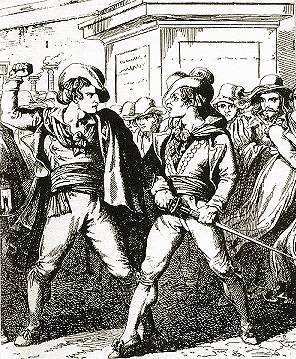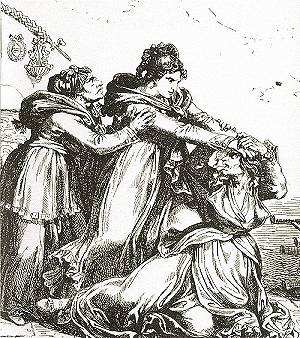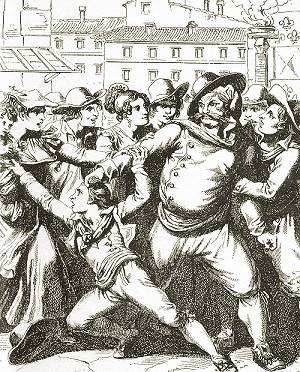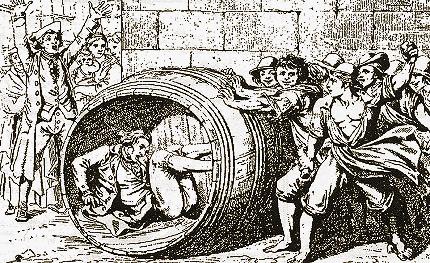Meo Patacca,
subtitled
Roma in feste ne i Trionfi di Vienna ("Rome's celebrations during Vienna's
victories"), may be considered the epic poem of the common people of Rome.
But while the hero, after which the work was named, is still popular in the city's
folk tradition, the name of the author is totally obscure to most romans.
Berneri, born and raised in Rome, was both a poet and a playwriter, and a member
of several literary academies of his time. He wrote poems, allegorical plays and religious plays,
but among his titles only
Meo Patacca is remembered.
No portrait of the author has been left, as well. But the great appreciation
for the popular hero, the quick-tempered Meo, who is a commoner himself, yet
represents a virtuous example of both valour and morality, gives reason for
such a long-lasting fame. Nevertheless, in the past decades very few editions of the poem have been
published.
Nowadays Berneri's masterwork has been relegated among the minor titles
of underground literature, an occasional find on second-hand bookstalls.
A few websites mention this poem, but Virtual Roma is the only
one where over one third of the original 1245 octaves can be read, with a parallel
translation, and a synopsis of the plot.
Inspired by a historical fact, Meo Patacca tells the story
of a typical brave, a young commoner clever in handling weapons, with a high sense of honour,
who serves his community by doing good deeds. In hearing the news that Vienna has been
set under siege by the Ottomans, he gathers the best braves in town,
and forms a small army for lending help to the Christian city. But shortly
before they set off, the news that Vienna's own troops managed
to free the city from the Turks reaches Rome, so the money raised for the
expedition is spent on public celebrations, which last several days.
|
 |
In the background, the love story of Meo with his mistress Nuccia
counterpoints the main events of the plot.
All the characters are modelled on typical roman commoners; some of the
situations described are indeed very amusing, and speckled with witty remarks by
Berneri, who enjoys playing the part of the storyteller, often adding his own
comments, from time to time indulging in the description of Rome's
famous spots, which are the fascinating setting of the whole story.
Furthermore, the poem provides a wealth of information about the way of life
in the late 17th century Rome: how commoners dressed, how an average house was
furnished, which greetings were used, and many more.
But Berneri's poem also testifies the fanatical atmosphere of Rome
under the centuries-old papal rule: the hero's mission can be read
as a mini-crusade, based on the religious perspective of an army of infidels
attacking a Christian city.
 |
In the last Canto this feeling ends up in
shere fanatism: triggered by a trivial pretext, the mob attacks the local
Jewish community, accused of having sympathized for the Turks. This, as well as
other excesses, are criticized by the same Berneri.
At the same time, the poem is an unvaluable source of historical
documentation on Rome's public celebrations: almost the whole second half
of the work describes in detail how pageants were set up, how the
different kinds of fireworks were made, how they were operated and what was their
effect, and also how wild the mob could turn taking part to the revelries
(an occasion for the low-class people to give vent to their miserable condition);
during these happenings, it was not uncommon for a passer-by to be injured or killed. |
The siege of Vienna that inspired the poem is a true fact.
On July 14, 1683, the Ottoman vizier Kara Mustafa Pasha (whose name is found in the
text as
Bassą, corrupted according to the dialect) set Vienna under siege,
for 60 days. The city would have fallen to the Turks, had
pope Innocent XI not called on the king of Poland John III Sobieski,
whose intervention proved successful. As the Ottomans withdrew, the
Austrian army entered Hungary, and took Buda.
Berneri's work was first published twelve years later, in 1695.
For a second edition no less than 100 years had to pass, but this time
the book was decorated with 52 tables drawn by the renowned roman engraver
Bartolomeo Pinelli (the ones shown in the page come from this series).
THE LANGUAGE
This is another interesting feature of Meo Patacca.
Berneri blended the outdated Italian
spoken in the 1600s with Rome's own dialect, which by those times
had already developed a character of its own; the result is probably a simplified form of the
language spoken in the streets, but this may be clearly understood considering that
Meo Patacca is one of the earliest literary works fully composed
in a non-official or non-literary language, not because of the author's lack
of knowledge of Italian, but as a corageous attempt of lowering the
level of speech, so that the common people too may have understood.
First of all, a certain Latin influence may still be told. For instance, both in dialect and in standard
Italian, Berneri uses an archaic "H" before every
inflection of the verb avere ("to have"), i.e. havere, whereas
in modern Italian only very few inflections of this verb maintained the "H".
The same occurs with nouns of Latin origin such as homo (for uomo, "man"), hora (for
ora, "hour"), and so on. Also the Latin conjunction et ("and") is frequently
used throughout the text. |
 |
Conversely, several words which in Italian are normally spelt with an "H" in Berneri's text
drop it:
occi (for
occhi, "eyes"),
ciamare (for
chiamare,
"to call, to name"), and so on. This is no longer found in modern roman dialect.
Interestingly, a few words are clearly derived from Spanish: having the
south of Italy been for a long time under the Spanish rule, this influence
evidently filtered through the dialect spoken in Naples, from where it partially
affected the Rome's own, as well. An example is the use of the definite article
el (which the Spanish, in turn, had inherited from the
Arabs during the Middle Ages); in Rome, the sound of this article was roughened
into
er. Then, during the 20th century, Rome's dialect somewhat
softened its sound, and in several modern texts the article returned to the
original spelling
el.
Another example is the use of the verb
buscare for "to seek": the meaning
of this verb ("to look for" in Spanish), in Rome changed into "to obtain, to get",
i.e. not the original action, but the result of the search.
Berneri's use of punctuation marks is somewhat whimsical, and from time to time
the spelling of some words fluctuates between two forms:
chalche « calche ("some"),
or
ajuto « aiuto ("help").
Also for many prepositions, more than one form is used, sometimes according
to whom is speaking (i.e. the different characters, the narrator, etc.):
per « pe',
di « de,
con « co', etc.
Also some typical Jewish-roman terms are found in the last Canto, whose first half
is set in the Jewish
ghetto (see also the
appendix).
 |
Among the many dialect terms, some of them are now
difficult to understand; during a time length of over 300 years some words turned
obsolete, but for an average Roman-speaking reader the poem is still clear enough.
Furthermore, being an early attempt of writing in dialect, Berneri added
several notes, thanks to which most of the terms now obscure may be understood. |
THE STRUCTURE
Meo Patacca is written in octaves, whose fixed rhyme scheme is A B A B A B C C,
and it is divided into twelve Cantos. Each Canto is introduced by an extra
opening octave, which gives a brief summary of the facts that follow.